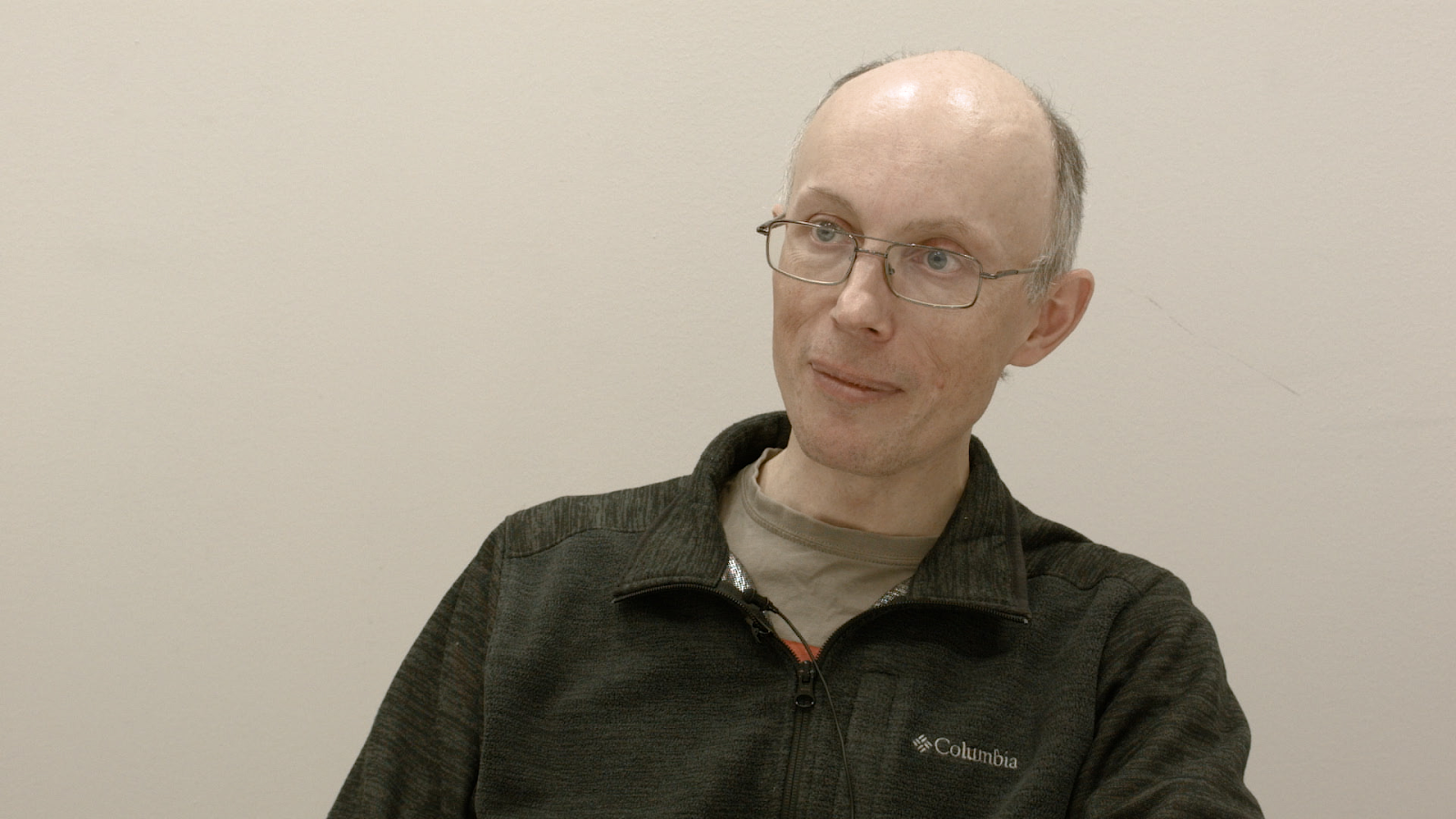
The demoscene is a kind of creativity at the junction of computer graphics, music and, in fact, programming, as well as the subculture that has developed around it. The first demo experiments date back to the 1980s - a time when a sufficient number of home computers appeared in Europe and the United States, the owners of which sought to make the machine perform tasks unusual for it. Usually these were short intros to hacked computer games, created on Commodore 64, Amiga, ZX Spectrum. The heyday of the demoscene fell on the 1990s, then it came to Russia.
Pyotr Sobolev, also known as frog, is one of the organizers of the ENLiGHT computer festival - the first demopati in Russia. In the first part of the interview to the DataArt museum project, he recalls computers of the 1980s and tells how the first intro and demo appeared in our country.
Start
- I was born in Leningrad in 1973. Mother and father were design engineers in the defense industry. As a child, I was fond of all sorts of pieces of iron, I soldered something on trifles - some simple schemes. The family had nothing to do with computer technology, but in the mid-1980s an idea arose in the USSR that everything connected with computers had to be forced and implemented in production. My father also started doing this at the factory. We bought the Iskra 226 computer, an analogue of the Wang 2200, something in between a home and a professional machine. It is assembled on microprocessor sections, such a specific architecture, unlike anything else, BASIC was the main language there. My father began to participate in this, because at the factory no one understood computer technology and anyone who took the initiative could take up this business.
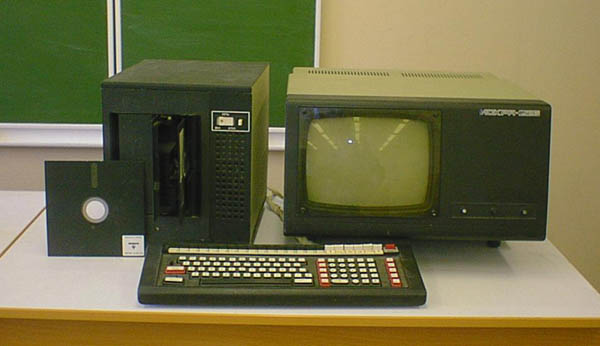
"Iskra 226" is an "electronic keyboard program-controlled computer" developed at the Leningrad Electromechanical Plant. From the collection of the Museum of Computer Science in Moscow
He began to bring home some books, tried to study something. As far as I remember, he dealt mainly with databases. In fact, "Iskra 226" is an office computer used at the enterprise mainly in the personnel department and for other similar purposes.
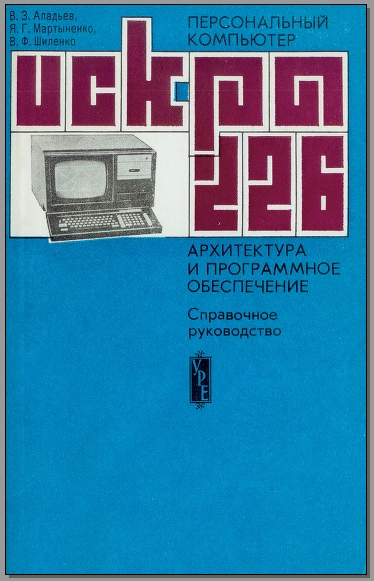
A reference guide for specialists and "everyone who wants to use the capabilities of software-controlled computers in their activities", 1988
I remember in the mid-80s my father brought home a hefty R-Base printout. Then it was a fairly popular DBMS. At some point, he called me to the factory to look at the computers. But I showed no interest.
At that time, I had already read all sorts of books, in general terms I imagined what a computer is. I even tried to solder something from publications in all kinds of magazines. But I decided for myself: I will begin to deal with computers only when they are freely available to me. Once every six months I didn't want to go somewhere and tease myself.
Undocumented features
Microcalculators became the next stage of my acquaintance with computing technology. It was about 1986. They bought me an MK-54. There were two basic programmable calculators in the mid-80s in the USSR - B3-21 and B3-34. At that time, neither one nor the other was already on sale. The MK-54 we bought was compatible with the B3-34.
Demonstration of operation of a programmable microcalculator Electronics MK-54 I
must say that B3-21 and B3-34 have different command systems, different architectures, and all the books that I came across were, unfortunately, about B3-21. This became a big problem because the programming for calculators was essentially machine code. You enter some icons, it turns out a program with a length of, say, 100 commands. She made some calculations, or it was possible to make a simple game like "tic-tac-toe", where you are given a field number, in which you mentally or directly on paper put a cross, and in which zero. Everything is very primitive. The indicator is digital, no letters. Well, no interactivity in the process of the program.
1986-1987 The Tekhnika Molodoi magazine began publishing a series of stories by Mikhail Pukhov - a mixture of science fiction and calculator programs, so that the reader could start and try something himself. For example, landing on the moon: enter in numbers the thrust, direction, press start, the calculator counts and shows how much is left to the surface. Now it sounds funny, but then it was very unusual and interesting.
Collector and historian of computer technology Sergei Frolov tells how readers used microcalculators to participate in the "game through a magazine." From an interview with the Museum project DataArt
Then the next calculator was bought - MK-61 . Then it was a whole problem due to the scarcity. Even if you had money, you could not go to the store and buy what you want. I had to wait, look. At some point I was lucky: we went to Electronics on Gagarin Street - the only large store of this kind in St. Petersburg - and bought this calculator. It was a little better than the old one, it ran more programs.

The Elektronika shop-salon on Gagarina Avenue in Leningrad was also an important meeting place for radio amateurs with resellers of parts. Photo source
In the mentioned series of articles, in addition to simple stories such as landing on the moon, they began to publish all sorts of interesting things: how to hang this calculator, how to make the indicator go out so that it displays not only numbers, but also some individual letters. In a word, what is now called "hack", although there were no such words then. They said "undocumented features." It was very interesting - to get from the machine what, in theory, it should not be able to. I did all this intensively.
In parallel, another topic appeared. The magazines "Radio", "Modelist-Constructor", "Young Technician" began to publish articles on assembling home-made computers. The choice was not very large. In "Young Technique", in my opinion, they talked about "Micro-80". I remember exactly that there was a series of articles about some kind of modular computer, where you first assemble something without connecting to a TV, with a simple indicator and a few buttons. Then - the monitor controller, then something else. They needed a bunch of microcircuits - it was completely unrealistic for me to assemble it. The magazine "Radio" published a description of "Radio-86RK", with a simpler circuit, but there it was not possible to get the 580VG75 display controller microcircuit - also in short supply. Everything else - please, but her - no.

Test sample of the personal computer "Radio-86RK", intended for assembly by radio amateurs, from the DataArt collection.
A little later, the magazine "Modelist-Constructor" began to publish a diagram of the computer "Specialist". The professional magazine "Microprocessor Tools and Systems" was also published, no longer for radio amateurs. There they printed a diagram of another computer - "Irisha" - more serious than the above. Like the previous ones, it was based on the 580IK80 microprocessor, an analogue of the Intel 8080. The possibilities were impressive, but the machine was very complex, with a bunch of microcircuits, including rare ones.
In conditions of scarcity
Another interesting point. At that time, every enterprise considered it its duty to invent its own computer. Now it seems silly, everyone thinks about compatibility. If you build your computer, what will you run on it? Then this question was not raised, because there were no programs. If you put it together and work well, you're done. My father brought the scheme "YUKU" (Juku - an Estonian computer. - Ed. Note). I tried to look for what it was all about - no trace. Also on 580IK80, the circuit is quite simple. They brought me boards, I tried to solder, but I quickly gave up, because I'm not a radio amateur. I soldered something simple, but of course I could not assemble a computer, especially a rare and incomprehensible one.

Juku E5101 is a personal computer manufactured at the Baltiets plant in Narva in 1988–1991. From collection
How was it then? Let's say I saw some kind of circuit in a magazine - it doesn't matter, a computer or, for example, an amplifier. You want to collect it. It's pretty simple now. You can go to the store and buy all the items you need. It was impossible then. You can buy a third from the list of these elements, the rest must be looked for, ordered, and a long wait. Desire is lost. Someone did this, of course. The main source of radio components is people who took them out of factories. It was a theft by and large, but in fact everyone was engaged in it, since everything was state-owned - like general. Everyone thought it was theirs. Practically legalized thing. This applied not only to radio components - everything. Everyone understood that if this process was abruptly stopped, many important things would simply become inaccessible. In addition, people at their assembly were engaged in self-education. Actually,enterprises turned a blind eye to the fact that citizens were doing something for themselves using their resources. Well, citizens received skills that could then be used in production.
Accordingly, from time to time something appeared in my house: some kind of LEDs, transistors, capacitors. Due to the specifics of the work, almost everything was from the military-industrial complex. I had to figure out how to replace consumer goods with them, which was used in schemes published in magazines. The military did not use such transistors or microcircuits, because they are unreliable and will not pass any acceptance.
Then, at some point, the topic with "Spectrum" began, and it, of course, inspired many. The idea was this: unlike all these devices - "Radio-86RK", "Specialist" and others, here, having assembled a computer, you immediately got access to programs already written abroad. There were a lot of them, this is a very big plus. Because for Radio-86RK, the then most popular computer, at the initial stage, maybe a dozen or two programs were available - that's nothing. And here - a color computer, games at once - whatever you want. At first, of course, all this was also problematic. It was necessary to look for components, of which the Z80 was the most scarce, since imports.

The board of a ZX Spectrum-compatible computer - the same one was soldered and used directly by Pyotr Sobolev without a case. Photo source
Informatics in a sports school
In the year 87, computer science lessons began at our school. These are the last two classes - 10 and 11. There were no computers at the school. A maximum of several calculators. And in the first lesson, we were simply told about BASIC, and we looked at the board and wrote down the operators in a notebook. Then they began to take us to a nearby sports school on Bryantsev, which had Commodore 64 computers. A rather unusual topic for the USSR, because at that time, mainly domestic "Corvettes", "Agates" were used in education, or "Yamaha" - MSX-2 - under contracts with the Japanese.
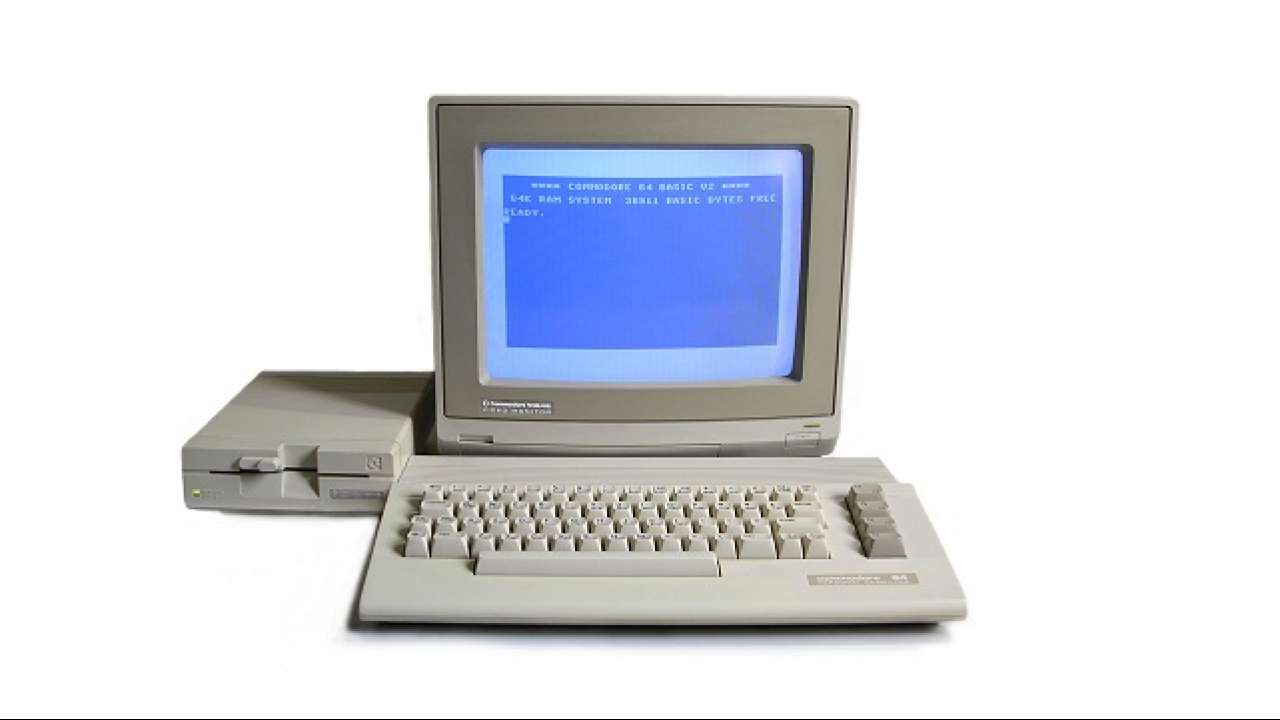
The Commodore 64 went on sale in August 1982. More than 15 million computers have been sold in 12 years
I'm lucky these Commodore 64s are good cars. At that time, it was just the top for us. Excellent color monitors, keyboard, sound. Much better than in Spectrum, and even more so in Radio-86RK and others. Accordingly, the games, for the most part, were better.
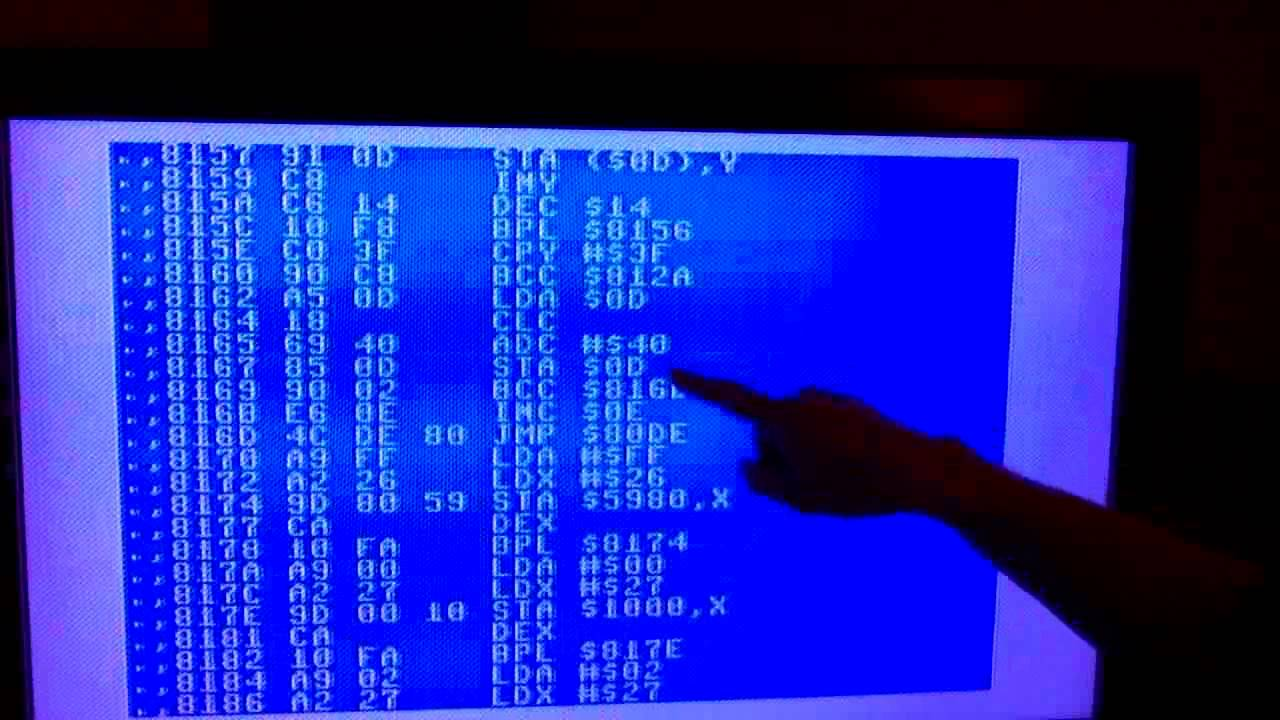
Screen of debugging assembly code
We were brought to the classroom, put two people for each computer, turned on. There BASIC immediately and the cursor blinks. I remember that in the first lesson we just ran the cursor across the screen and rejoiced. We were shown how to change the cursor color. This, of course, fascinated us. I think if the computers were black and white, most likely we would not be so interested. But this nice blue screen with a cursor of any of 16 colors, of course, attracted us.
We started going there, and not only for official computer science classes, which were held once a week. With friends we dropped in after school, and sometimes even skipped something like physical education. We were not obliged to let us in, but, fortunately, the teachers at this school were understanding. Mark Solomonovich Segal, Elena Isaakovna Lozinskaya and the secretary Elena Petrovna always found places for us. You come in, open the door, see that everything is busy and wait in the corridor until the computer is free.

Certificate of attendance at an elective in computer science. From the personal archive of Peter Sobolev
We played relatively little. First, they didn't give us. Because when there is a lesson, and suddenly some people come and start playing - this is unacceptable from any point of view. We were doing business, trying to study something. First - BASIC. There were only two books about him, both in German. We had English at school, although we didn't really know it, to put it mildly. They took a dictionary, tried to understand something. But the usual German-Russian dictionary was not very helpful. In a book about computers, the words are different, especially since there are many compound words in German. We tried to change something in existing programs, launch and see what was affected. It didn't work out - you change something else. So they gradually learned, without much supervision from the teachers, who themselves did not know much about these computers. They knew the basics of BASICa simple program could be taught to compose. But let's say about graphics or sound - they didn't know anything. Mark Solomonovich, it seems, once worked on large machines, and this is a completely different area.
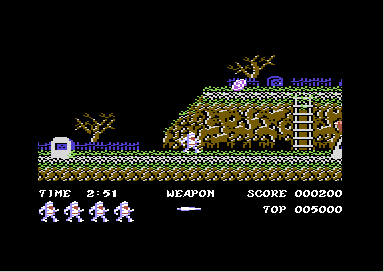
Ghost'n'Goblins, 1985 , Commodore 64
When people left, but some of the teachers remained, we used to play. In "Arkanoid", which was done very well in terms of sound and graphics. Later I saw a lot of it on what machines, I can compare. There was a game called Ghost'n'Goblins, where a dude walked around a haunted cemetery. In the three-dimensional game Driller, you had to figure out where to go, what to do, where to shoot, so that something would switch and open. Quest type. I remember we drew maps on A4 sheets. Since this game did not come to us in a box, but simply in the form of a file, we did not understand the meaning of what was happening there at all. When they drew and saw the dodecahedron, they realized that it was like some kind of planet. Another good game was Cauldron II: such a bun was jumping around the rooms where ghosts, all kinds of skeletons lived, and it was necessary to collect something. The standard game of those times. Sat,figured out, also drew maps. We probably paid 50-50 attention to games and something serious.
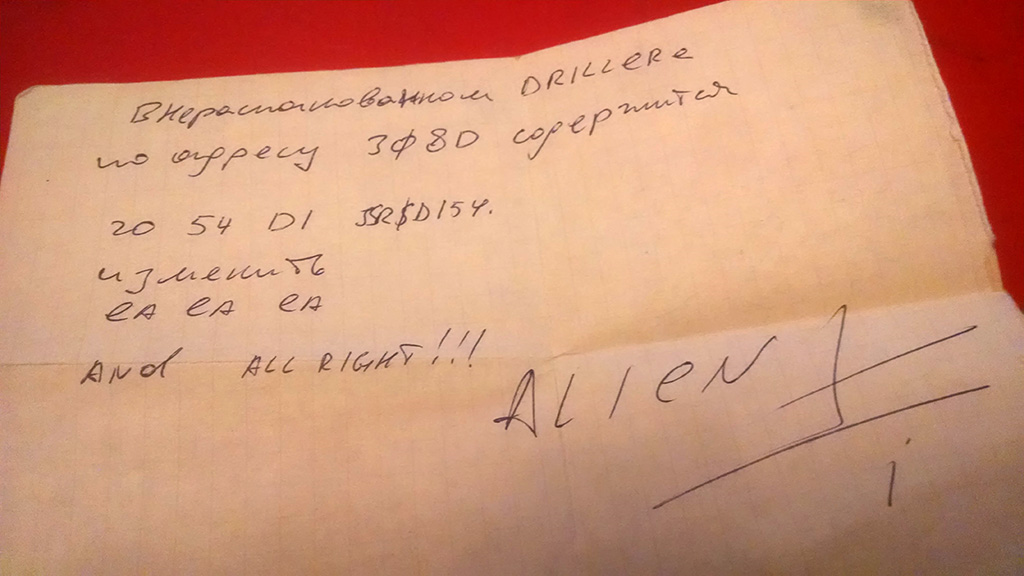
"Instructions on how to patch the DRILLER game code, left by one of us at school on Bryantsev Street ($ EA - 6502 processor NOP instruction)." From the personal archive of Peter Sobolev
Laboratory assistant
With the institute in those years, the topic was very clear. You either go to college or to the army. Now the army does not have such a negative context, but then there was perestroika, they started talking about hazing, and I really didn't want to go there. An acquaintance had just returned with compromised health after serving somewhere in Komi, guarding prisoners. In short, I signed up for preparatory courses at the Polytech. In our class, everyone tried to go there - it was believed that he was the best from technical universities.
I failed my preparatory exams. In physics, I got ticket 19 (as I remember now), to which I did not answer. I went to take the regular exams with a stream and failed again - I got the same ticket. Well, naturally, I did not teach him - who comes across the same ticket twice! It turned out to be me. I flew by, but in terms of age it was a year before the army. I went to work as a laboratory assistant at LITMO. Then he was not as famous as he is now. An ordinary technical university, like LETI, LIAP and many others. I became a laboratory assistant at the Department of Computer Science. My duties included soldering wires at the stands, which students pulled out with all their foolishness, and once a month take out the trash from the classroom. Then I could do whatever I want.
In the auditorium where I worked, there was Iskra-1030. Such a Soviet PC / XT with 512 kilobytes of memory and a terrible quality green monitor, from which the eyes were very tired. I tried to do something on it. In the next auditorium across the corridor stood Iskras 226, like my father at work. Compared to Iskra 1030, they were even worse. On this one you can run at least some things intended for the PC. And there is nothing at all - only BASIC, in fact.
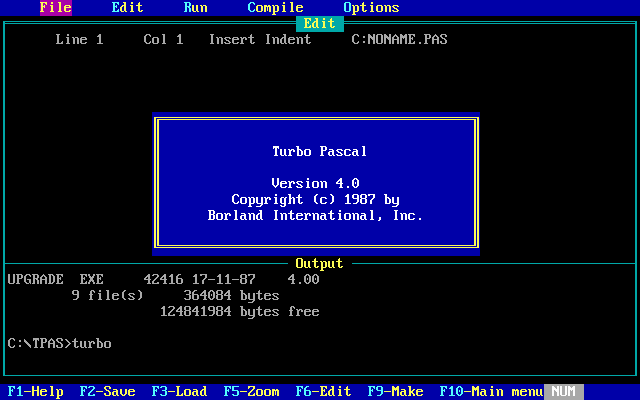
Turbo Pascal 4.0 working environment
On Iskra 1030 I wrote something in Turbo Pascal 4.0. This is the first Turbo Pascal to feature a more or less normal menu environment. It's hard to talk about games there, because normal games did not work on such a machine. Some "Xonix", "Tetris", with difficulty - "Prince".
Then the Bulgarian Pravets 16 appeared in the same auditorium. This is also PC / XT, but at a higher level. There were already many things going on there, but the monitor was also black and white.
Commander Keen 4 game on Pravets 16
Next to our auditorium there was the laboratory head's auditorium, the main one at the department. There was a PC AT 386SX / 16 - a very cool car at the time. There were games on it, it had good graphics, although the memory there was, it seems, only 1 MB. When the car was free, one could sit behind it without any problems. The teachers - employees of the department, saw that I was interested in something, and did not just come to play and did not mind.
Home computers
At the same time, there was a parallel story that began a little earlier, before the institute. During the years of perestroika, we began to put up with the United States, general topics were discussed, and many tried to do their own business, although the Soviet people had no idea of business. Read, watched films - and forward. A family friend started a joint venture with the Americans. The office was called Vabog because his name was Valery Bogolyubov. For this case, a PC / AT 286 computer was brought to him from America. 640 kilobytes of memory, 20 MHz - then it was very cool, then even the PC / XT 8 MHz was considered a serious machine. The computer had a color monitor, however, CGA. All this arrived in a large, iron-bound chest, which I still have at home and everyone who sees it asks what it is. Since our friend had no idea what to do with this computer,And then I was just fond of all this, he gave it to us for a while.

The computer was at my house. There was DOS. You turn on the computer, boot from a floppy disk. The cursor is blinking, it says MS-DOS, version 3.10 and that's it. Text mode, no graphics. At first I tried to study commands, then someone gave me a couple of discs with games, the same Turbo Pascal, something else. Then, when this computer was taken away, by the time I had already graduated from high school, they bought a Commodore 128 home. This is such a strange, even at that time, machine - an attempt by Commodore to sit on two chairs. On the one hand, they tried not to lose Commodore 64 fans, who loved games very much - a lot of them were written for 64. On the other hand, they tried to get into the business so that text editors with 80 columns would work fine. Spreadsheets are all there is. Looking ahead, they did not succeed. They were not the only ones who were so smart. That is, in fact,They crammed the entire Commodore 64 circuit into one computer and added the Z80 and another video controller nearby, which displayed 80x25 text on another monitor. Well, or 640x200 monochrome graphics. In fact, it was a two-processor computer, in which the processors, of course, could not work in parallel. You had to choose. And two video outputs for two monitors.
TV commercial for Commodore 128, 1985.
I sat at this computer for a long time, wrote something, understood, it was quite interesting. Two monitors at that time were also cool.
However, I did nothing useful. Not a single demo or intro - nothing. All that I wrote then was some kind of semi-finished product. Let's say I figured out how to draw beautiful colored stripes and, satisfied, do something else. That is, in fact, writing was reduced to simply dealing with some topic. Sprites there, for example, or how to reprogram fonts. I figured it out and that's it. This was the case with the Commodore 64 and 128. More or less I began to write something complete, already on the PC.
After the Commodore 128, the next home car was the Nivka. A very strange domestic PC / XT for industrial applications. At that moment, everything was already bent - the end of perestroika, so such things were relatively easy to buy - they were not particularly needed by anyone.
It was a PC / XT, megabyte memory, 4.77 MHz clock, 8086 processor (not an 8088!), With a CGA color monitor. The trick was that this machine was in the Full Tower form factor. I had fun with this computer for a long time, overclocked it. Either changed the quartz, or rearranged the jumpers, made 8 or 10 MHz. At the same time, the disk drive controller began to jump out of the crib funny. Apparently, it was heating up. There were Soviet beds, everything jumped out of them at any opportunity. I tied it in with threads - it worked stably.
Ray tracing
In addition to Pravets and 386SX, the institute also received other cars. A PC / AT 286 with an EGA adapter was installed in my classroom. There was also an Amstrad PC1640 with monochrome EGA. Interestingly, this PC / AT 286 with color EGA was Yugoslav, and in a military version. Serious thing. The metal case is very rough, with cooling fins, the monitor is corresponding, rubberized on all sides. If they hit, to amortize. It was not a bad machine. 16 MHz, in my opinion.
Two more PS / 2 model 50s were installed in the laboratory manager's room. These were PC / AT 286s, in my opinion, about 20 MHz with a Micro Channel (MCA) bus. The graphics on these machines were MCGA (MultiColor Graphics Adapter). This is VGA, only without high resolution. It was possible to output 320x200, 256 colors. More precisely, in our case, 64 shades of gray, because monitors were black and white. On PS / 2, we first tried to entertain ourselves with ray tracing - we counted all sorts of beautiful glass spheres that are reflected and refracted in each other.
Ray tracing is one of the algorithms for obtaining a photorealistic image. You write a program, set simple primitives in it: a sphere, a cube, a plane, a light source. And she for you long and tediously draws all the reflections by points and how what is refracted. It turns out beautifully.
Back then, 3D packages like, say, Maya, were only on expensive and inaccessible computers like Silicon Graphics. On the PC, everything was just beginning. Calculating the most beautiful picture using your own program was cool and quite adequate.
Student
After a year of work as a laboratory assistant and having fun with computers, I decided that it would be logical to enter the same LITMO. The guys from my class, who spent a year at the Polytechnic, only talked about studying, they could not even think about anything else, which was alarming. Here, too, was not quite a freebie, but quieter. Therefore, I began to enroll in LITMO at the Department of Computer Science, but I didn’t get through on points. I remember I went to the deputy dean in charge of the reception. He took with him a person from our department - for authority. I say: "I want to go to BT". He shows the list: “This is the daughter of one, this is the son of another. Sorry, I can not!". As a result, I got into the newly created department of mechatronics, and 60 percent of the people on it were like me - those who did not go to VT.
Mechatronics is, roughly speaking, instrumentation, a mixture of electrical engineering, electronics and mechanics. Naturally, there was no particular computer technology there. There were all kinds of TOE, strength of materials, design, materials science ... By my diploma, I, as a result, an electrical engineer. As for computers, we had classes in the specialty "applied mathematics" on the CM-4 every few weeks. She stood in a separate room behind glass and blinked lights, like in films. Very fashionable. On the other side of the glass were 6 terminals with black and green text. Such a multi-user machine. Students tried to enter something, but it was tough. To write a program, you had to start a text editor. It starts up a little, you have a cursor. You drive in this program, then you exit the editor, start the compiler, the linker. At the same time, everythingas a rule, it periodically falls, you start over. I was there once or twice, then I realized that I didn't want to. I did not feel romance at all and began to think what to do.

Since 1979, the CM-4 computer has been produced in the USSR, Bulgaria and Hungary.
Programs had to be written in Fortran. Then it was a fairly popular language for computing. And I decided: I'll go home, sit down at a normal PC ("Nivka"), write in Pascal. There is a fairly simple task algorithm. Then he printed the results on a printer, took a Fortran book, leafed through it, looked at what operators there were. I took the program in Pascal and changed the operator to FORTRAN. Moreover, I did not understand many things. For example, that lines should be separated in Fortran by tabs, and so on. In general, I replaced it to make it look like it. I printed out the results, went to take it to the teacher. At the same time, he did not hide what he was doing on the PC. He looked. “It's strange,” he says. "It seems like it shouldn't work in Fortran." But the results are correct! Rolled. Such was the test.
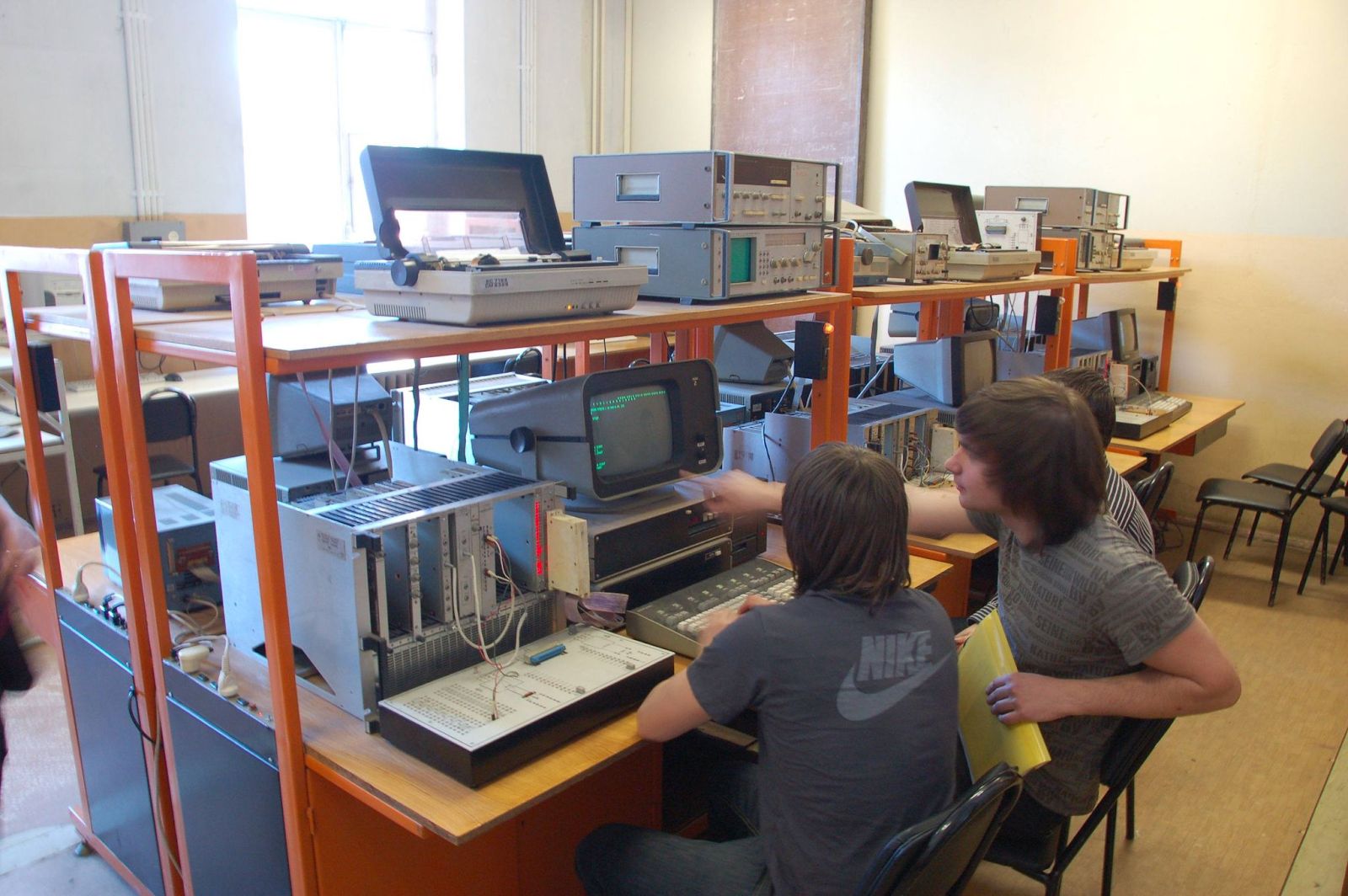
, -, . 2008 . , 1990-
LITMO became known at the expense of the Parfyon department (In 1991, on the initiative of professors Parfyonov and Vasiliev, a project to create a system for the preparation and employment of gifted schoolchildren and students began at ITMO SPbSU. - Ed.). When I entered, Novikov was the rector. In the last years of my studies, Vasiliev replaced him. We had very few computers; they were not involved in the educational process at all, except for the CM-4. Parfyonovskaya department was located in the basement. There is a separate door with a peephole with a camera. At that time - just like a foreign bank. Once I went there to pick up something and was just shocked.

Founders of the Department of Computer Technologies: Vladimir Vasiliev, Vladimir Parfenov and Alexey Sigalov, at the banquet of LITMO graduates in 1990. Photo source
LITMO in those years was tattered walls, parquet flooring in places, old doors, skewed windows. And you go into this department - there is carpeting, transparent partitions, people are sitting at PC computers with color monitors. This is, uh ... digital divide. The department is like a state within a state. But due to her and other things, Vasiliev pulled LITMO to famous universities.
Getting to know the demoscene
In the neighboring school, where we were taken as children on the Commodore 64, the teachers had a certain set of programs. Among them there were those who were not intended for anything - they just showed beautiful graphic effects to the music. We sometimes put on and watched, because it's cool. But we, of course, did not know what a demoscene and demos were. Now everyone goes to the Internet, reads foreign press, books, watches the news - and then that was not the case. We had practically no idea about foreign culture. All they knew was from films that were censored, that is, fairly neutral. The same was true for music. Therefore, many things were new to us.
In the last year of going to school on the Commodore 64, we began to make acquaintances with people who had this computer at home. Basically, these are guys whose parents went abroad. Truckers, sailors - people who ended up abroad and could buy something there. There were 3-4 people who had a Commodore 64. We went to their house, exchanged software. No networks, no modems. You just come with a pack of floppy disks (300 kb each) and say: “I have this and that. Let's watch". They put it in the drive, looked: “Oh, this is interesting to me. We copy ". There were copying programs. When you start it, it writes: "Insert the original disk." You insert: "Insert the disc where to copy." This several times. It took about 10 minutes to copy one disc.
So gradually we got something new. Then I met one person - Kirill Antonov, nickname GhostRider. I do not know where he disappeared, disappeared into thin air many years ago. He had a Commodore 64, and he more or less knew English and corresponded with foreigners. He established contacts with some groups that, purely for the soul, were engaged in writing programs: music, some kind of graphic effects. Cyril wrote to them, they sent him CDs. Then we started to get into the concept of "demoscene".
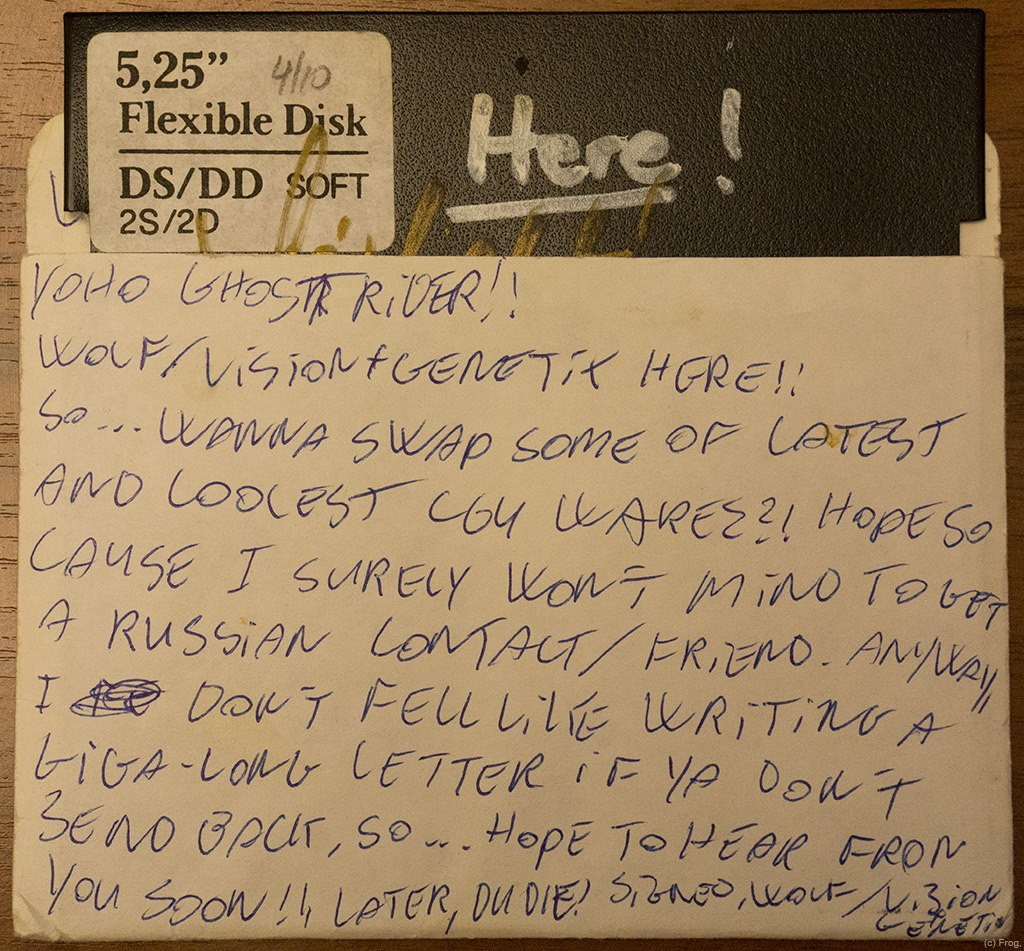
"Hello GhostRider!" Letter to Kirill Antonov from abroad, written on an envelope with a floppy disk containing programs
What did we get our hands on? First, programs where something beautiful is shown on the screen to music. Secondly, the programs are magazines. Run diskmag (disk magazine - Ed.) As an executable file. You are presented with a menu. There are articles, interviews. You come in, you read. There were also noters - also executable files. Like diskmags, only from one article. As now, README files are put in the archives. Then they were not. On the Commodore 64, there weren't any text files as such. Because there was no single text format that all programs could read. You turn on the computer - you have one BASIC, you can only download and run something. Therefore, all these readme were in the form of executable files - and this was a big plus in terms of opportunities for self-expression. People wrote such an executable readme, ran. The text could appear in different fonts,different ways. Sometimes it appeared gradually, as if from a typewriter. Erasure was imitated - as if a person was writing right in front of you. And to the music. There were special noters, when you could not only read the text, but also write the answer. You press a button, you have a cursor, and you can write all this yourself. Then you press another button, a copy of the executable file is made, only with your text. You can add your own music if you want.You can add your own music if you want.You can add your own music if you want.
Intro and demo history
After looking at all this, we began to feel the culture of the demoscene. Demo is, formally speaking, graphic effects combined with music by the script. The foreign authors of the demo were inspired by films that we did not know. For example, "Back to the Future" - we did not watch it then, but they all knew what it was. You watch the demo, there are constant references of some kind. Now to the musical group, then to the hero of the film. In the running line they say hello to someone, they mention something. You read and try to understand what they mean.

Cracktro of the late 1980s (short intro to anticipate hacked games) by Xadez Society for Commodore 64
An important point: the demos didn't start suddenly. At first it was popular to break toys. Back then games were distributed on discs, discs were copy protected because they had to be sold. For this purpose, some kind of physical damage could have been inflicted on the disc, so that the game, when launched, checks whether it exists and thus knows whether it is the original disc or not. There were other tricks too - for example, they wrote between the tracks. The pirates broke this case and told who did it. At first they just wrote in the beginning: "broken by such and such." Gradually, the inscription began to improve. First, the iridescent was made, then, so that it went. They also sent greetings or fakes to their competitors - other pirates who broke something crookedly, or did it later than them. Gradually, this all resulted in the so-called intro - from the English Introduction.Such a small demo from one part. That is, you no longer just had an inscription, it shimmered in every way, flew in a sinusoid, a logo of some kind jumped on top. More music played along the way.
Let's say someone broke the game in order to copy and distribute illegally, then someone next made endless lives in it. He also added his intro. When you start such a disc, first one intro is shown, then another, and a third. It used to be five. Each team had so-called swappers, who were engaged in sending disks by mail. This is how it all came down to us.

1990 Cracktro (short intro pre-hacking 3D International Tennis game) by IKARI for Commodore 64
There was no question why this was done. It was obvious that this was interesting. You did a cool thing, others appreciated it. Because if you come across a Commodore 64 naked, without everything, just with a built-in BASIC, you won't do anything like that even close. It is necessary to write in assembler, to know very well how the equipment works, how to program a video chip, a sound chip. You need to understand how to optimize all this and how to pack it in a small amount of code. Because, when these intros were sculpted for games, the game itself should still somehow fit into the disk and load quickly enough.
The game was packed, the intro was attached to it, also packed. The type of archiving. When launched, the Intra first unpacked itself, showed it. Then you pressed space, she unpacked the game or the next intro. All available memory was used, including screen memory. You could often see something flickering on the screen, that is, this code is unpacked directly into the screen memory. It was all very unusual and interesting. It was clear that every person who did something put a part of his soul into it, took the time to achieve a goal - some effect, something unusual. He used the existing equipment in a new way.
Over time, the intros were reborn into separate large demos. They consisted of several parts. You launch it, you are shown some kind of effect - plasma or scrolling running. Press the spacebar - the next part appears. It takes a few minutes to watch one part to the end. Now it is generally not clear why. There are no special dynamics, this was also rarely connected with music - it just went in the background. But then that was enough. We just watched for a long time how something was flying there, and trudged about how it was done.
Triad's Red Storm Demo for Commodore 64
I remember being impressed by the Fairlight's Legoland demo. There was such a part - with the help of ray tracing, mirror balls flew around a pillar, with reflections. It is clear that this could not be done on the Commodore 64, simply because the processor there was 6502 1 MHz. The authors simply took a more powerful Commodore Amiga machine, did it all frame by frame, and then put together such a cartoon. But then it was not obvious to us, the impression was that this was really happening.
Demo of Legoland by Fairlight for Commodore 64
In some works, text scrolls were made in a very unusual way. Then they were the center of any demo. Usually some text is crawling at the bottom, and something is happening at the top. And you, as it were, in parallel, so that it would not be boring to read, you are still looking at some man running above. These scrolls were very varied. Shimmering, the letters were spinning in different ways, wavyly distorted, were multi-colored, bouncing. It was real art (in the sense, creativity).
Read the rest of the interview here .